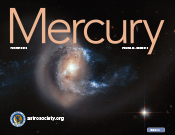Summer 2016 - Volume 45, Number 3

Table of Contents
[17] Reflections on a Journey to Totality, Linda Shore
My trip to Indonesia gave me much more than a total eclipse of the Sun.
[25] A Totality 2017 Eclipse Workshop, Edited by Paul Deans
Selected excerpts from presentations at an Americal Astronomical Society Eclipse 2017 workshop held in June, 2016.
[33] The Eclipse, The Media, and Being Outside the Path, Joe Rao
Don’t fret. Eclipse 2017 will ultimately be the media event of
the season.
[37] Astronomy in the News
A seasonal dust storm pattern on Mars, an unexpected excess of giant planets in a star cluster, and the universe apparently expanding faster than expected. These are some of the discoveries that recently made news in the astronomical community.
Departments
[4] Perspectives, Paul Deans
August 21, 2017: It’s Not Just About Totality
[5] First Word, Linda Shore
In the Path of Totality
[7] Annals of Astronomy, Clifford J. Cunningham
Of Moonbows, Rainbows, and Marco Antonio de Dominis
[8] Astronomer’s Notebook, Jennifer Birriel
Solar Eclipse 2017 and Citizen Science
[10] Planetary Perspectives, Emily Joseph
Jovian Encounters
[12] Strange New Worlds, Harvard-Smithsonian Center for Astrophysics
Globular Clusters and Interstellar Civilizations
[13] Armchair Astrophysics, Christopher Wanjek
Faintest Early-Universe Galaxy Detected
[14] Education Matters, Brian Kruse
It’s Elementary
[16] Reaching Out, Jay Ryan
Eclipse 2017 Cartoons
[45] ASP Tidings
ASP’s Award Winners for 2016
[50] Sky Sights, Paul Deans
Time Again for the Perseids
[53] Reflections, ESA/Rosetta
The Transit of Mercury
Reflections on a Journey to Totality
by Linda Shore
I had been the ASP’s Executive Director for just two months when I met Melita Wade Thorpe — founder and president of MWT Tours, pioneer of astronomy themed vacations, and force of nature. Since 1984, Melita has been escorting groups of astronomy enthusiasts around the globe to marvel at the aurora borealis from Iceland, witness meteor showers from Botswana, and visit the collection of giant telescopes perched high above the Atacama Desert of Chile. She had led solar eclipse tours to just about every amazing location on Earth, including Africa, Patagonia, and the Marquesas.
I was shocked when Melita invited me to be one of her “expert lecturers” for an eclipse occurring two years in the future — the Great Java Sea Solar Eclipse of 2016. I explained that having never witnessed totality, I wouldn’t be very helpful to eclipse aficionados who certainly would know more than me. But she thought having an experienced astronomy educator who also happened to be an “eclipse virgin” would be a perfect addition to the trip.
A Totality 2017 Eclipse Workshop
Edited by Paul Deans
Editor’s Note: An Eclipse 2017 workshop, sponsored by the American Astronomical Society, took place in Carbondale, Illinois, on June 10 and 11, 2016. The first day’s sessions were recorded and are available for viewing on YouTube, but be warned — the entire recording is more than nine hours long! (Because of audio problems, you might want to start here with the second speaker.) Much of the second day was devoted to (non-recorded) group breakout sessions.
I was particularly interested in the discussion by Lou Mayo (Eclipse 2017: Through the Eyes of NASA), who focused on what NASA doing for Eclipse 2017. So I’ve made his presentation the lead item. I’ve also included some excerpts from presentations by Charles Fulco (Talking About the Eclipse), Michael Zeiler (How Many People Live in or Near the Path of Totality? and Capitalizing on Social Media), and Fred Espenak (The Eclipse of 1842).
The Eclipse, The Media, and Being Outside the Path
by Joe Rao
In recent months I’ve heard some folk express disappointment that the news media has given short shrift to next year’s “Great American Total Solar Eclipse.”
As a person who works in the news media, I can assure all of those disappointed in the coverage (or maybe I should say the lack of coverage) that Eclipse 2017 is going to be one of the big national news events in 2017. The “problem” with the news media is that they do not concentrate on the specifics of a prospective news story until less than a week before the event. Then every news-gathering agency will head toward that event like moths attracted to a flickering light.
Largest, Widest Orbit “Tatooine” Bolsters Planet Formation Theories
Institute for Astronomy, University of Hawaii
A team of astronomers announced the discovery of an unusual new transiting circumbinary planet (orbiting two suns). This planet, detected using the Kepler spacecraft, is unusual because it is both the largest such planet found to date, and has the widest orbit.
Reminiscent of the fictional planet Tatooine in Star Wars, circumbinary planets orbit two stars and have two “suns” in their skies. The new planet, Kepler-1647b, is Jupiter-sized in radius, the largest of all currently known circumbinary planets, and has an orbital period of 3.0 years, the longest of any confirmed transiting planet.
The detection of Kepler-1647b is significant for two reasons. First, its large size and large orbit are very different from those of all other known circumbinary planets. All of the previously identified Kepler circumbinary planets are Saturn-sized or smaller. Also, most of these planets tend to orbit close to their host binaries, near the so-called “critical instability radius”, where if they orbited any closer, the planet’s orbit would be dynamically unstable and the planet would be ejected from the system or crash into one of the stars.
The second significance of the discovery of Kepler-1647b is that this planet resides in the habitable zone of its host binary, a surprisingly common occurrence for circumbinary planets discovered by the Kepler space telescope.
